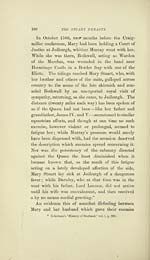Stuart dynasty
(205) Page 167
Download files
Complete book:
Individual page:
Thumbnail gallery: Grid view | List view

MARY QUEEN OF SCOTS. 167
of them eager to soften the adverse verdict clinging
to his name, hut neither in sober narrative nor
attractive fiction has it been found possible to adhere
to truth even in its barest outline, without presenting
the reader with a character destitute alike of virtue
and refinement. It must, however, be allowed that
in the backward condition in which James V. had left
Scotland, there was both need and scope for the rude
talents of a resolute Border soldier such as Both well.
His adherence in early life to the Regent Mary of
Lorraine, when the Protestant Lords deserted her,
gave Mary Stuart reasonable cause for welcoming
the Earl to Court, and rebying on his sword in time
of peril. According to Knox and Buchanan she
conceived an affection for this nobleman some time
before Darnley's death, and the two histories written
by these prominent contemporary actors on the stage
of Scotland's Reformation, speak openly on the sub-
ject. On the other hand their averments are unsup-
ported by any proofs ; nor do we elsewhere hear of
such calumnies being so early repeated even by the
divers bitter enemies who surrounded the Scottish
Queen. The course of events nevertheless conspired
to make such statements — in appearance at least —
well founded. Chalmers, in his voluminous Life of
Mary Queen of Scots, avers that so early as 1561
Bothwell had matured a plan to carry the Queen off
to Dumbarton Castle, a design doubtless utterly
unknown to Mary herself, while after June 19, 1566,
this bold adventurer's efforts to seize the voung
Prince of Scotland were notorious.
of them eager to soften the adverse verdict clinging
to his name, hut neither in sober narrative nor
attractive fiction has it been found possible to adhere
to truth even in its barest outline, without presenting
the reader with a character destitute alike of virtue
and refinement. It must, however, be allowed that
in the backward condition in which James V. had left
Scotland, there was both need and scope for the rude
talents of a resolute Border soldier such as Both well.
His adherence in early life to the Regent Mary of
Lorraine, when the Protestant Lords deserted her,
gave Mary Stuart reasonable cause for welcoming
the Earl to Court, and rebying on his sword in time
of peril. According to Knox and Buchanan she
conceived an affection for this nobleman some time
before Darnley's death, and the two histories written
by these prominent contemporary actors on the stage
of Scotland's Reformation, speak openly on the sub-
ject. On the other hand their averments are unsup-
ported by any proofs ; nor do we elsewhere hear of
such calumnies being so early repeated even by the
divers bitter enemies who surrounded the Scottish
Queen. The course of events nevertheless conspired
to make such statements — in appearance at least —
well founded. Chalmers, in his voluminous Life of
Mary Queen of Scots, avers that so early as 1561
Bothwell had matured a plan to carry the Queen off
to Dumbarton Castle, a design doubtless utterly
unknown to Mary herself, while after June 19, 1566,
this bold adventurer's efforts to seize the voung
Prince of Scotland were notorious.
Set display mode to:
![]() Universal Viewer |
Universal Viewer | ![]() Mirador |
Large image | Transcription
Mirador |
Large image | Transcription
Images and transcriptions on this page, including medium image downloads, may be used under the Creative Commons Attribution 4.0 International Licence unless otherwise stated. ![]()
| Histories of Scottish families > Stuart dynasty > (205) Page 167 |
|---|
| Permanent URL | https://digital.nls.uk/94767359 |
|---|
| Description | A selection of almost 400 printed items relating to the history of Scottish families, mostly dating from the 19th and early 20th centuries. Includes memoirs, genealogies and clan histories, with a few produced by emigrant families. The earliest family history goes back to AD 916. |
|---|

